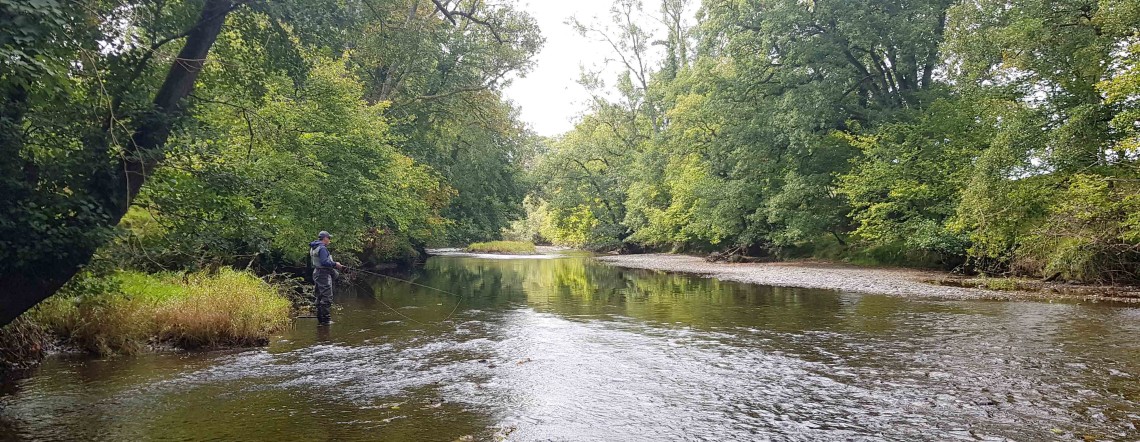More than enough rain fell at the beginning of August and all our rivers became pretty full, which certainly made a welcome change. The Wye in particular was hovering around 2 feet on the Llanstephan gauge and there was a kind of peaty stain to it, which I presumed came out of the Irfon. The question on our minds was when, or if, the salmon would now start to run into the upper river. Nothing was seen for a while, but then JF from Walton on Thames fishing at Nyth and Tercelyn with a Cascade caught a small cock fish, rather coloured and with some fungus. The next day PG from Sussex, also on Nyth and Tercelyn, had a coloured hen of 10 pounds on a Flying C. Gary Price also had a small hen, from the tail end of the Rectory’s Rock Pool on a Black and Copper Flying C. MH from Swansea had another coloured hen on a Black and Gold Flying C from the same pool. One could surmise that these were long-term residents which the high water had encouraged to start moving up. Then from right up at Craig Llyn, Nick Gibbon reported two salmon for his day: one a coloured fish of 30 inches, but the other a fresh one of 27 inches. This last was a good sign and after a couple of days the situation looked more cheerful with signs of new fish arriving. On the 4th, Dennis Cotter while fishing his beloved beat of Llangoed and Lower Llanstephan had a 10 pounds cock fish, still with sea lice on it. Tim Hughes netted it for him. Nick Howell reported an 11 pounds fish from Glanwye on a tube fly. Ed Brown caught a monster of a salmon at Spread-eagle, 46 inches long and weighing 31 pounds. (This big fish was actually a little light for the length). The middle and lower rivers were now coming back into condition and Wyesham reported 12 and 15 pounds coloured fish on a Mepps, followed by a 15 pounds silver salmon on the fly. It has been said that it is the fish you lose which you remember, but there is a distinctly tragic note in a report from JM of Bristol who was apparently going through a Dark Night of the Soul following the loss of a big salmon on the Orchard pool of Lower Llanstephan: “Absolutely heart-breaking outcome for any Salmon fisher. As it all goes slack and so quiet you instantly know this will be part of your life for ever. Got a good look at it twice: deep fish way into the 20s and quite fresh too.”
Meanwhile coarse fishermen had their problems with slippery banks, but their results were generally good. DW from Abergavenny fishing at How Caple Court had 7 barbel to 10 pounds 12 ounces and 8 chub to 5 pounds 4 ounces. He also reported a 35 minute struggle with an unseen leviathan which kept taking him downstream yards at a time, but just would not come back. He wondered if it might be a salmon or a carp. Well, anything’s possible of course, but my guess is that it might have been an accidental foul-hooking. When a fish is hooked in the jaw, sooner or later you can start to get it turned and lead it by the head. But a barbel has which managed to entangle itself and get hooked in the tail for example, would behave exactly as described. It would be next to impossible to draw a tail-hooked barbel upstream against the current while much life was left in it. MH from Wolverhampton appreciated advice from keeper Stefan at Middle Hill Court where he caught 16 barbel and 20 chub, while CB from Swansea caught 1 barbel and 30 chub at Upper Breinton.
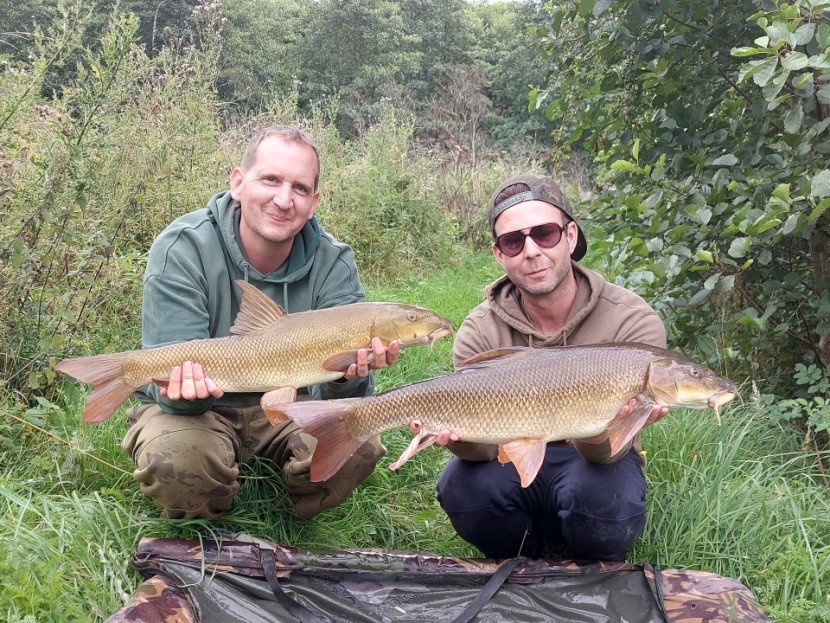 Courtfield barbel - LF from Banbury
Courtfield barbel - LF from Banbury 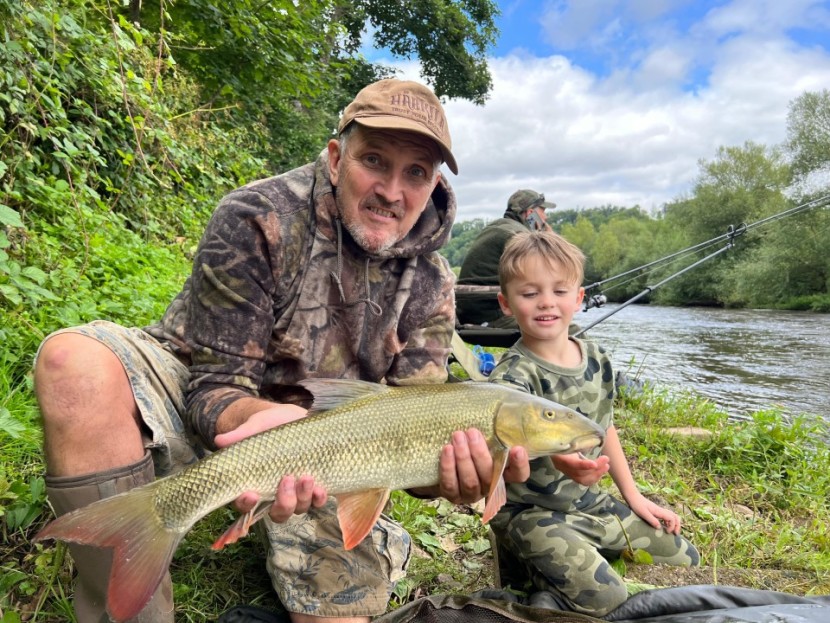 DG from Tewkesbury on Wyebank
DG from Tewkesbury on Wyebank 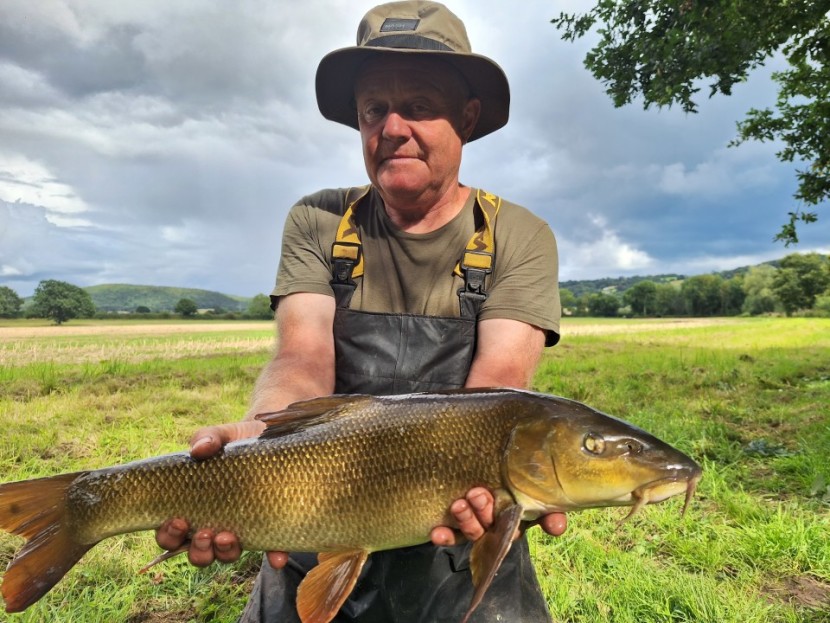 Middle Hill Court - GA from Bristol
Middle Hill Court - GA from Bristol 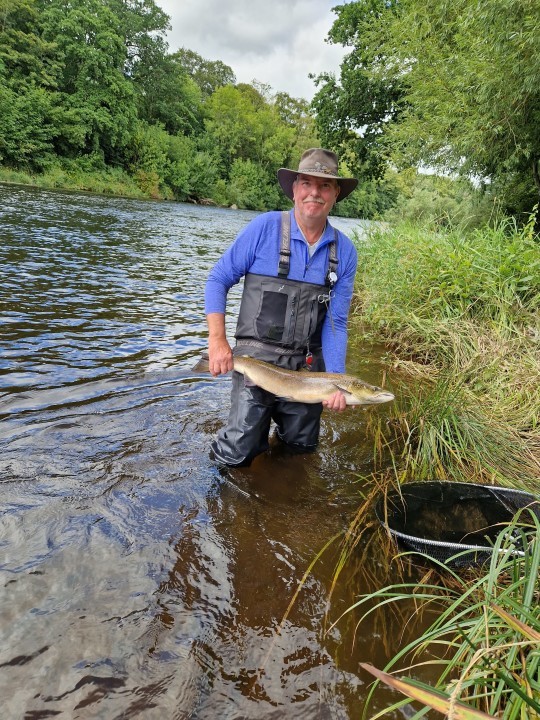 The Rectory - IW from Brecon
The Rectory - IW from Brecon CJ from Malvern reported 30 brown trout from the Towy at Llandeilo during what was really a reconnaissance for night sea trout fishing – and sewin were in fact spotted moving upstream. DB from Kidderminster fished close nymphs as few fish were rising at Lyepole on the Lugg. He caught 9 trout and 14 grayling, mostly small. YA from Mountain Ash was not happy with his unsuccessful day at Llwyn On: “…not worth pay to fish any more it’s gone terrible nothing caught.” On the other hand IS from Beddau caught 4 trout from the same lake on the same day and 3 more on the following day.
TM from Wellington reported a creditable 4 trout and 18 grayling from Craig Llyn. IW had a small coloured salmon with a reddish vent from the Rock Pool at the Rectory and on the 8th Steve Boswell reported a 12 pounds fresh fish from the Weir End beat of the Ross Angling Association water. The fly used was a size 8 Bann Special, a shrimp design featuring golden pheasant plumage which is also a favourite of mine. Kevin Willis fishing a Willie Gun tube had a 2 sea winter salmon from the tail of Dolmeudwy at Llanstephan. Ricky Reno had a 3 sea winter fish on spinner from the Moor beat of the Clifford estate, while Upper Bigsweir reported 3 salmon on fly: 15 pounds, 18 pounds and also a 6 pounds grilse. DP from Taunton had a good day on the Wye at Strangford with 3 barbel and 40 chub, but complained about finding discarded fishing line. TM from Wellington had a wonderful time at Craig Llyn during a spectacular fall of flying ants with fish rising everywhere. He reported 5 trout and 20 grayling, including a remarkable fish of 50cm – yes, that’s a grayling well over 19 inches in old money!
GD from Knutsford fishing at Middle Hill Court reported 8 barbel and 7 chub. PB from Churchdown with a friend reported a good day on the Irfon at Cefnllysgwynne. They caught 14 trout to 14 inches and 3 grayling, all on parachute dry patterns. BW from Hereford experienced a wash-off on the Rheidol as sluices were opened and electricity generation turbines accelerated. RS from Westbury was another who found a dead bat attached to lost tackle and an indicator on the upper Usk at Cwmwysg Ganol. Don’t risk handling a live bat, but for the sake of wild life do try to remove broken nylon and flies from trees.
Meanwhile, some plain tales from the hills: FVR from Ankeveen reported 8 trout from Cambrian AA’s Llyn Morwynion, while BH from Oxford was troubled by paddle boarders splashing around in remote Llyn Berwyn. He made up for it later with a 16 inch fish from Llyn Teifi. A weekend of wind and showers followed. SL from Hockley Heath had 10 trout and 2 grayling from the Dee at Llangollen Maelor. SA from Leominster managed to extract a trout from a gap in the vegetation on the Arrow at Monkland, but complained it is “near impossible to fish this beat.” It certainly has always been a candidate for adoption and some radical pruning. SB from Birmingham with a friend had 2 barbel, 46 chub and 12 dace from the Wye at Sugwas Court. GA from Bristol fished at the Home Fishery for 3 barbel and 15 chub, having pinned his faith on “hair rigged spicy sausage” in 8mm pellets. A couple of days later he fished the same beat for 4 barbel and 8 chub, remarking again: “they seem to like the spicy sausage.” Well GA, I imagine they do; I mean who doesn’t? SJ from Solihull with two friends caught 4 barbel and 192 chub while fishing Holme Lacey 3 and Lechmere’s Ley. AM from Dorridge was fishing up at Doldowlod where dam releases from the Elan upset the wading at times, but he recorded 16 grayling. By the end of this wet and windy weekend, once again we had a muddy flood running down both our rivers. After a 3 hour drive, RG from Westbury was unlucky to be faced with impossible conditions and a wash-off at Cwmwysg Ganol.
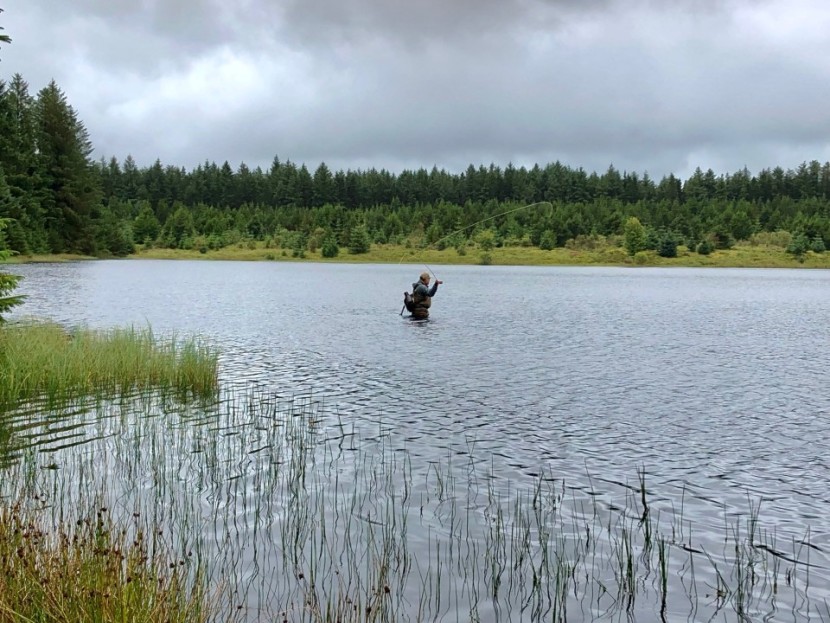 Llyn Berwyn - Lyn Davies
Llyn Berwyn - Lyn Davies 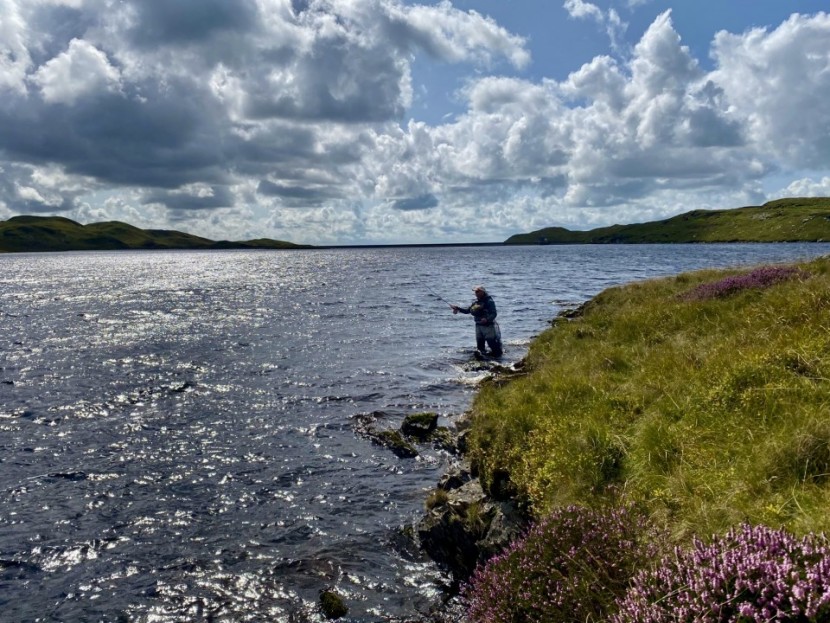 Llyn Teifi - Lyn Davies from Swansea
Llyn Teifi - Lyn Davies from Swansea 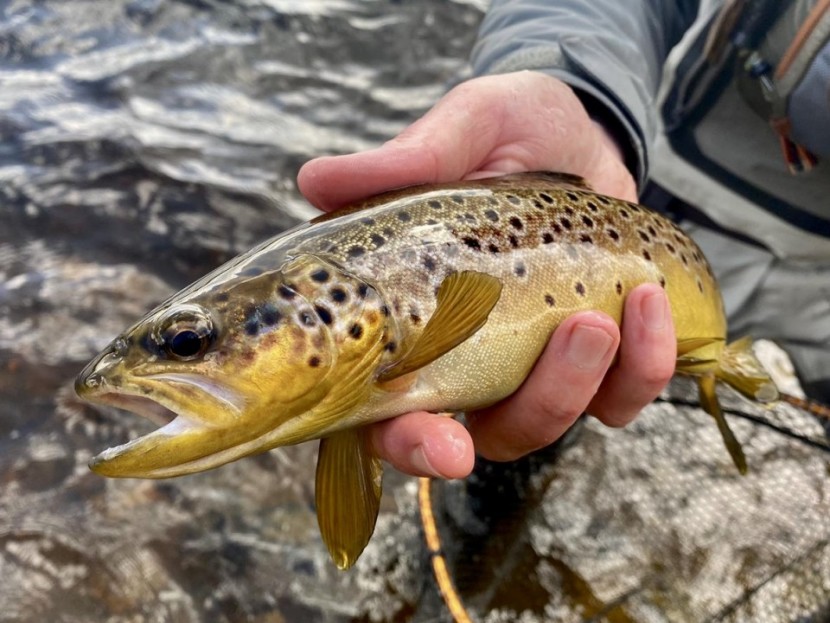 Llyn Teifi trout - Lyn Davies
Llyn Teifi trout - Lyn Davies 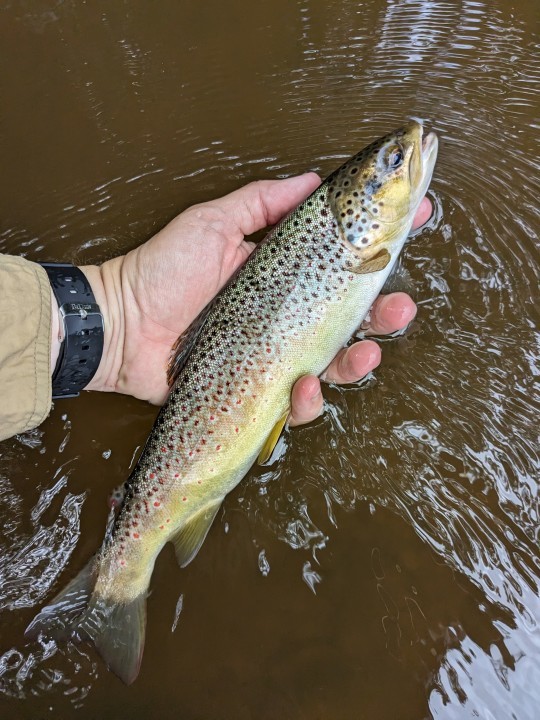 Honddu Lower Stantion, CT from Cardiff
Honddu Lower Stantion, CT from Cardiff On Tuesday 15th Nathan Jubb had a 9 pound salmon on fly before the flood reached him at Upper Bigsweir. AT from Basingstoke reported 1 barbel and 27 chub from Foy Bridge, while CT from Cardiff fished the Honddu tributary of the Monnow at Lower Stanton for 14 trout in slightly coloured water. The River Loughor on the border with Carmarthenshire was up to a good height and salmon were taken with the spinner at the Pontardulais AA water.
On Deepdale Beck up in Cumbria, SW from Normanton took 14 small trout and a grayling on nymphs. DA from Warsash Southampton reported a rare sea trout from the top of the Usk at Pantyscallog. GP from Chertsey with a friend took a trout and 25 grayling including a large one from the Wye at Abernant. Also at Abernant, JB from Winchester on a salmon ticket remarked on a couple of anglers fishing the opposite bank to Abernant Stream. I don’t think that is anything to worry about; the WUF Abernant beat is single bank just there as the map makes clear. I believe the beat opposite is Chapel House Abernant and the opposition has every right to be fishing there.
SJ from Hockley Heath had good fishing if tough wading on the Dee at Llangollen Maelor, reporting 3 trout and 7 grayling. MM from Woking was prospecting the upper Towy at Llandovery for night fishing and caught 5 browns with one sea trout lost. The night following didn’t work out unfortunately, due to high winds and heavy rain. JH from Bristol fished the Glynneath AA water and recorded 11 trout on nymphs. My pal Lyn Davies from Swansea headed up to his beloved high lakes and fished Llyn Teifi, recording 11 trout of about a pound despite wild weather. He usually fishes a pair of dries around in the ripple. JP from Wolverhampton with his dog tramped round all three of the Teifi Pools on the same day and I think Lyn was the only other human being he saw. CM from Stockton on Tees recorded 99 trout from the Raby Estate of the Tees. The mind boggles; what energy!
Given the high water conditions, there was a slightly surprising wait for salmon reports from the Wye, but on the 18th Gary Price had a 10 pounds salmon on a Conehead Francis tube, again from the tail of the Rock Pool at the Rectory beat. Wyesham at the lower end had a fly-caught 6 pounds salmon on the 20th.
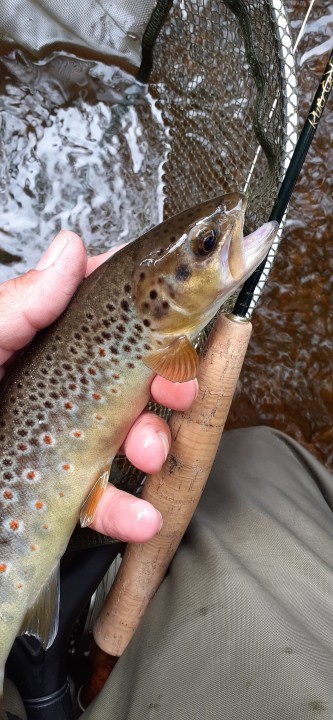 Cammarch trout - JA from Rhayader
Cammarch trout - JA from Rhayader Of the coarse fishermen, SM from London caught 40 chub ant Holme Lacey and Lechmere’s Ley while his friend had 2 barbel and 29 chub. SL from Alcester with two friends fished at Middle Hill Court and reported 24 barbel from 5 pounds to 9 pounds 8 ounces, plus 20 chub, all on feeders with pellets and boilies. SE from Brentwood had 18 small barbel and 2 chub at Wyebank.
FB from Salisbury reported a big trout in a brace caught on the MTAA Taff water, while RA from London had 10 trout on wet flies fishing the Llandeilo AA water of the Towy. FB from Salisbury reported a 2 pounds trout from the Usk at Ashford House, while Joe Alexander from Rhayader took 11 trout from the lower beat of the little River Cammarch. According to Joe’s reports this tributary does seem to be fishing a little better these days, although he does complain about the overgrown state of the stream. Another salmon from Wyesham on the 21st: this time a fresh 8 pounder on a Flying C. We weren’t exactly setting the world alight with these salmon fishing results! The Towy and even the little Loughor further west seemed to be doing at least as well. MH from Swansea blamed the colour lingering in the Wye: “…like fishing in cold tea.”
On the 23rd JD from Malvern with a friend had a good evening on the upper Wye at Craig Llyn. They got 5 trout and 4 grayling, starting with nymphs and fishing spinner patterns before dark. It was all fuelled by a goodie box of left-overs from a wedding feast along with a few glasses of something appropriate and sounds to me like the perfect evening. PB from Churchdown with a friend fished the same beat a day later and they had a bag of 11 grayling and 4 trout, noting an autumnal feel to the weather with mists early and late. One of the grayling was 17 inches.
PL from Tredegar took his grandson fishing on the Usk Reservoir and they caught 3 trout: “1st time I’ve taken my 8 year old grandson fishing and what a pleasure it was…all the way home it was when can we go next?” On the other hand RJ from Abergavenny took his 7 year old daughter to Llwyn On the following day: “We only managed an hour or so before she wanted to leave, as they do when they are that age.”
My own slightly unconventional theory about taking children fishing is that some of them get the fishing bug from somewhere almost without adult intervention, but many of them never do and never will, even if you offer them free days on the Test! When I was a little boy, I always wanted to fish even though my father and uncles didn’t fish and knew nothing about the sport. My father always wanted to walk and climb hills in his free time; I just wanted to look over bridges. Now we have four adult children, of whom just one likes to fish, and six grandchildren, of whom I suspect one might turn out to be a contender. But the basic message is that you can’t push it. I think it was Colin Willock of The Angling Times who gave an opinion that children should be taken fishing only when they have asked to go two or three times. Then give them every opportunity and encouragement you can!
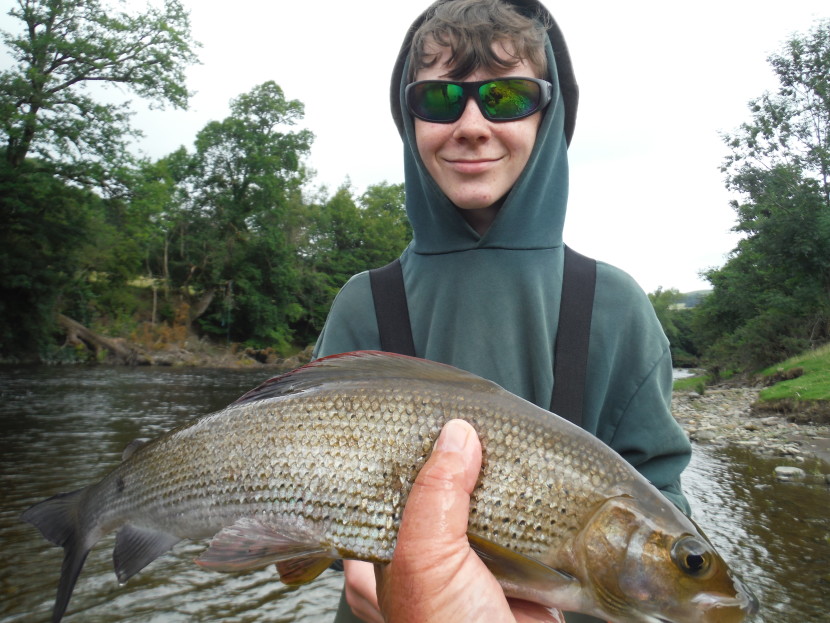 13 year old Jochem Schouten with his first grayling taken on a Deer Hair Emerger
13 year old Jochem Schouten with his first grayling taken on a Deer Hair Emerger 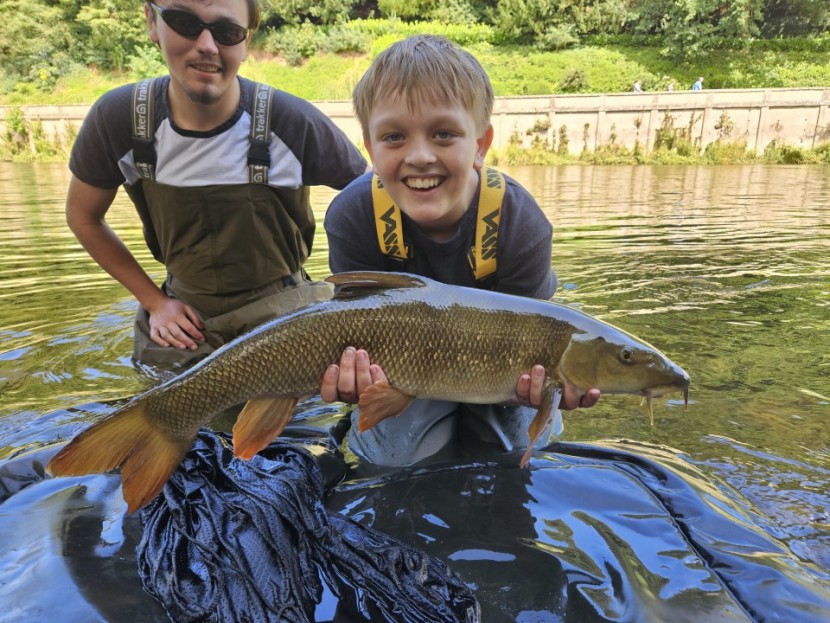 Lower Canon Bridge - DC from South Croydon
Lower Canon Bridge - DC from South Croydon 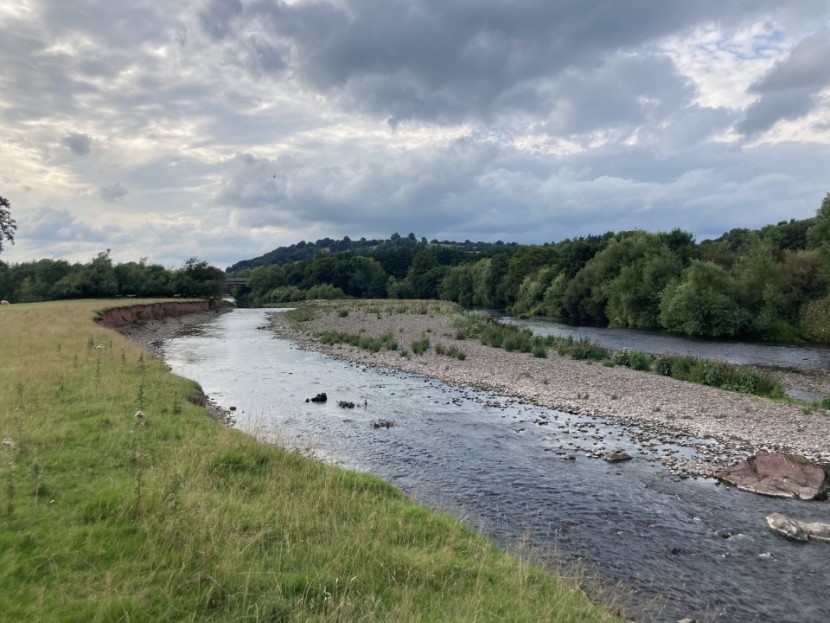 Dinas - BT from Shellharbour, Australia
Dinas - BT from Shellharbour, Australia There were still hopes the Wye salmon fishing would liven up. IW from Brecon had a coloured hen fish on a home-made spinner from the Rectory on the 23rd. Wyesham reported a 12 pounds salmon on the fly and a 16 pounds fish on a Mepps spinner the following day. There were also some late reports of salmon at Wyesham from June and July. Wyesham was in the results again on the 27th with fly-caught salmon of 11 and 22 pounds. Apart from a lost fish up at Llangoed’s Orchard Pool, there were no other reports during the weekend and it was Wednesday 30th before Wyesham reported a fish of 12.5 pounds and another of 11.5 pounds. Coarse anglers were as busy as ever during the same August bank holiday. AJ from Brighouse had a sunrise session at The Creel and caught 3 barbel and 18 chub. MW from Ross with a couple of friends fished at Holme Lacey 3 and Lechmere’s Ley, catching a barbel at 7 pounds and 85 chub to 5 pounds with luncheon meat and pellets. Joe Alexander from Rhayader fished the Edw at Cregrina, the water being high and coloured, and took 12 trout on dry flies. In the North, SW from Normanton fished the Tees again at Barnard Castle, catching 15 trout and 8 grayling, also on dries. PR from Burry Port caught 8 trout from the Usk’s Breconshire Fishery, while Lyn Davies with a friend searched the margins of Llyn Berwyn with dry flies on the step and cast basis and came up with 25 trout in total.
DE from Menithwood with a friend reported 9 trout and 2 grayling from the Dinas beat of the Usk on 29th August. That is a remarkable report in itself: we haven’t heard of grayling from the Usk before. Otherwise there were some queries about the fishing rights at the bottom of the beat where it joins with Abercynrig. This is a subject which comes up perennially, possibly as Dinas and Abercynrig used to be marketed together and the joining place is staggered left bank and right bank on the Cynrig Pool. More than once I have found people with a Dinas ticket fishing down the right bank of the Cynrig pool, which is actually Abercynrig’s fishing. There isn’t much practical access to the pool from the left bank. The WUF answered (A) strictly accurately, that the law in such cases allows you to fish from your own bank to halfway across the river and no further, and (B) perhaps more helpfully, that good manners dictate that you avoid pushing into a small river to fish immediately opposite another angler. There is plenty of room on the mile plus of Dinas to allow for fishing without conflict with any other beat and neither beat is “over-rodded.” SW from London had a good evening on the Usk below at the Glanusk Ty Mawr and Canal and Rivers Trust beat, taking 9 trout initially with nymphs and later with a very traditional Olive Quill. AP from Haverfordwest with a friend had 18 mountain trout on dries and hoppers from Llyn Teifi and Llyn Egnant, while GD from Bristol had 8 trout on dry flies from Llyn Silyn. RR from Bristol caught 3 barbel and 25 chub from the Wye at Strangford, while NG from Bampton had 30 chub trotting with a centre pin reel at Middle Ballingham and Fownhope No 5.
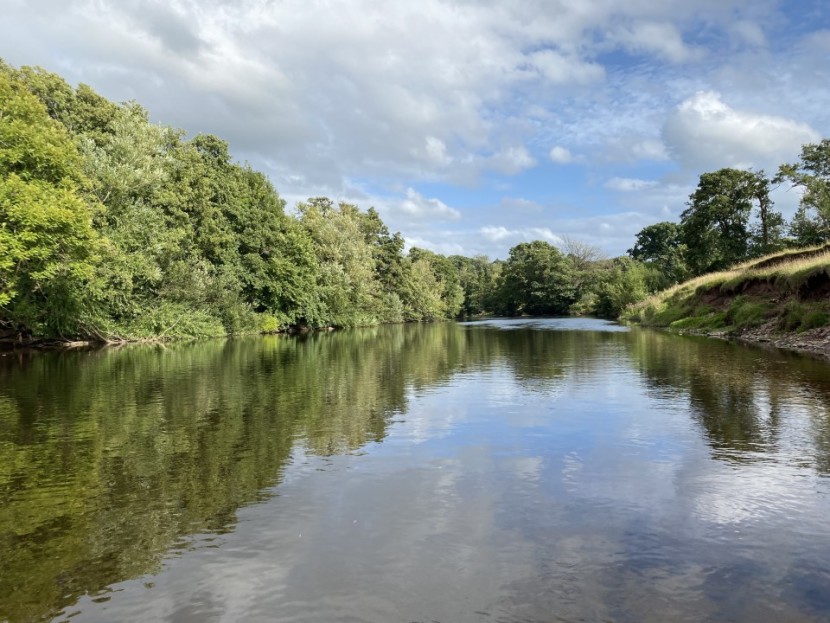 Abercynrig - PD from Cheltenham
Abercynrig - PD from Cheltenham 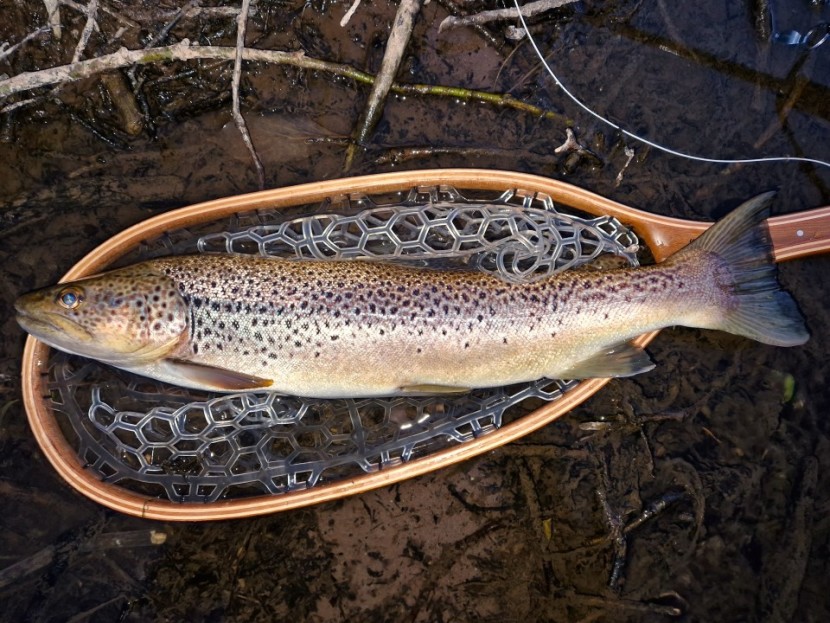 21 inch Upper Tower trout - BG from Exeter
21 inch Upper Tower trout - BG from Exeter 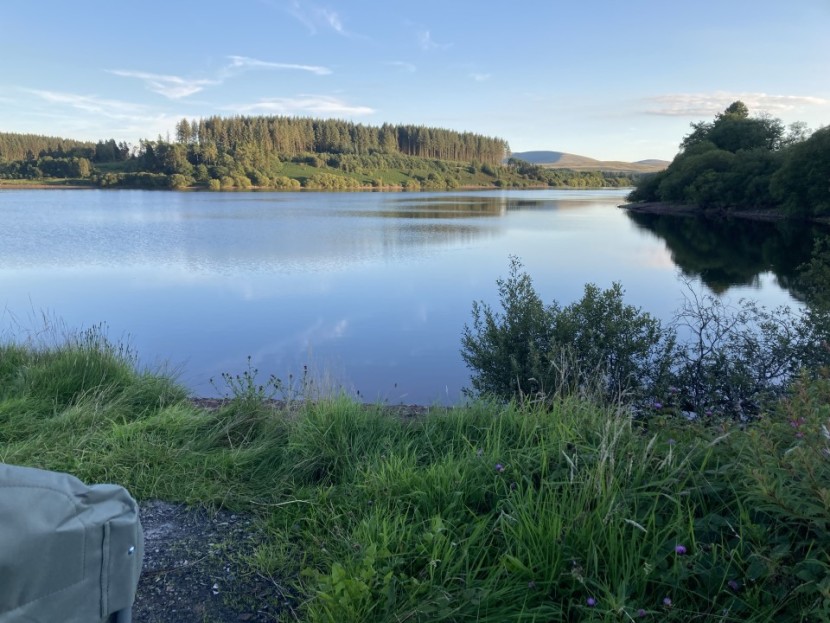 Usk Reservoir - AJ from Llandeilo
Usk Reservoir - AJ from Llandeilo Joe Alexander from Rhayader had another outing on the River Cammarch and commented: “…seems hardly anyone is bothering with wild streams.” I do get that impression from reports this season, and yet this is some of the most interesting fishing we have. Joe also wrote: “I think a structured trimming on all wild streams needs to be done!” I can see why he might say that, but can only comment that there is not an existing fund for contractors to do this work. The owners of our Wild Streams, most of them farmers, don’t make enough income from the fishing rents to carry out much if anything in the way of maintenance. Voluntary work brings its own problems, including that of insurance and public liability. The Foundation is certainly aware of the problem and is looking to solve it.
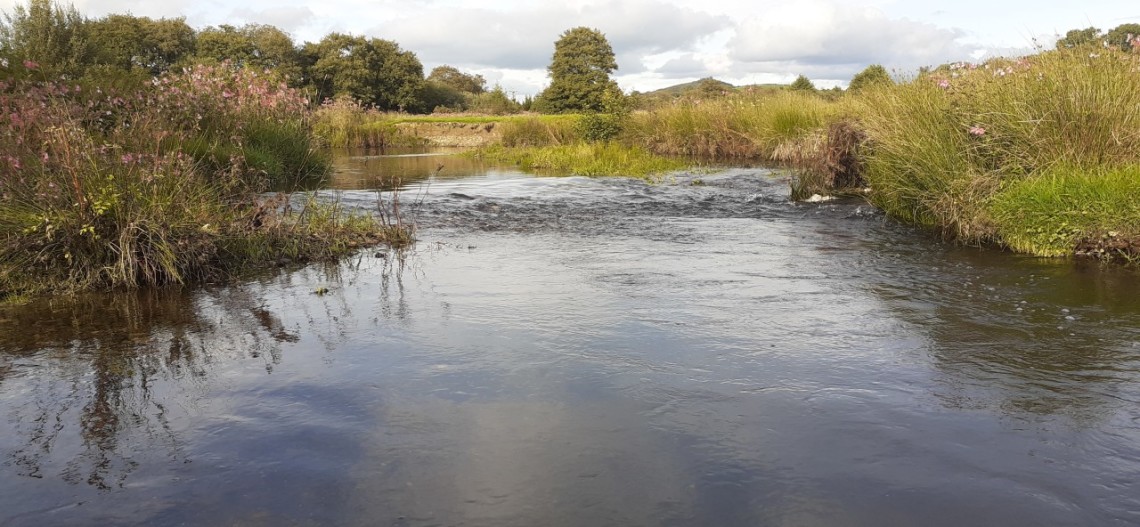 River Cammarch - Joe Alexander from Rhayader
River Cammarch - Joe Alexander from Rhayader On the subject of Wild Streams, something happened a couple of years ago which still makes me chuckle when I think about it. One hot summer day I was working my way up a shaded part of the Arrow. Natural rises were not much apparent, but fishing a dry fly in likely places had brought up a few modest trout. I reached a largish pool, mostly a big slow eddy, but into the head of it came a long run of rippling fast water which looked as if it would surely contain trout, probably more than one. I suppose the usual approach would have been to work up the run from the bottom, casting straight up. However, bushes were projecting over the surface from the bank and after some thought I elected to push between the bushes to a wading position just to the side and halfway up the run. I would cast the Parachute Adams to the top, let it run down past me and finally turn at the waist to follow it down to the bottom and the main pool.
Which is exactly what I did and the little brown fly with its white cap came bouncing down the surface of the current as planned. What happened next must have taken little more than a second, although somehow the procession of time seemed to slow as events unfolded in front of my eyes. First I distinctly saw a small brown trout, maybe 8 inches long, rising steadily from the depths to intercept the fly. He definitely meant to have it and experience told me that, provided I didn’t time the strike badly, this one was probably mine. Trout in small streams usually make their mind up quickly. But a couple of inches below the fly, something happened to this confidently rising fish. There was a sudden moment of confusion, a nervous twitch off to the left and then my riser was wriggling rapidly down and out of sight, the fly untouched. I had time, I remember, to think to myself that this was slightly odd. Brown trout in small streams, unlike spooky rainbows in catch and release commercial waters, usually follow through once committed to an attack. All was clear when the fly had travelled barely 6 inches further down the run. Suddenly a large head broke the surface and a spotted back followed it as a big trout rolled onto the fly and practically hooked itself well back in the throat. This was a 16 inch fish which then dashed around in anger and made a couple of determined attempts to reach tree roots which had the taut leader singing and the little 7 foot rod bent double. You can imagine that, what with the limited space and the bushes, there was some drama before I finally got it under control and into the net. Having released the fish, one which certainly made my day, I sat down on the bank with a quiet giggle to myself (it was not only the late John Wilson prone to do that) while considering exactly what had happened.
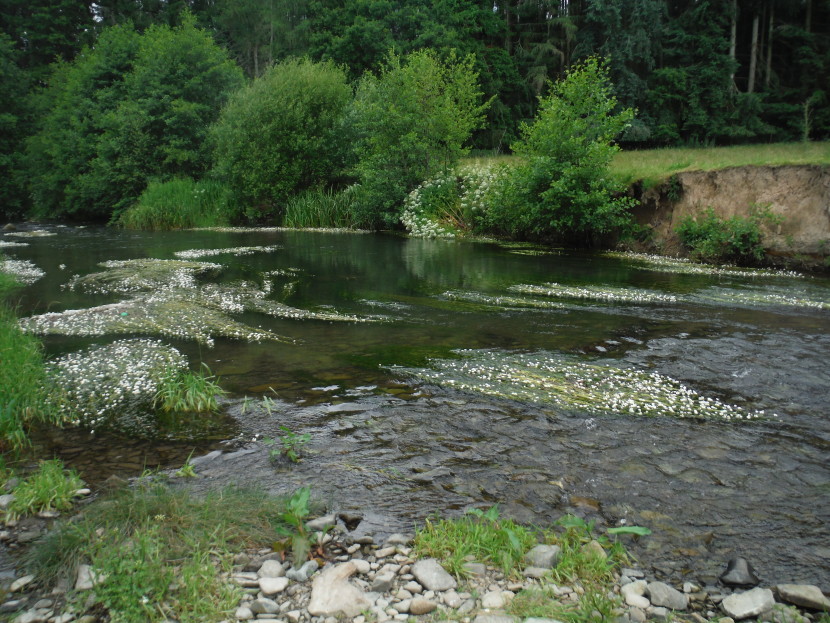 Summer on the Arrow
Summer on the Arrow 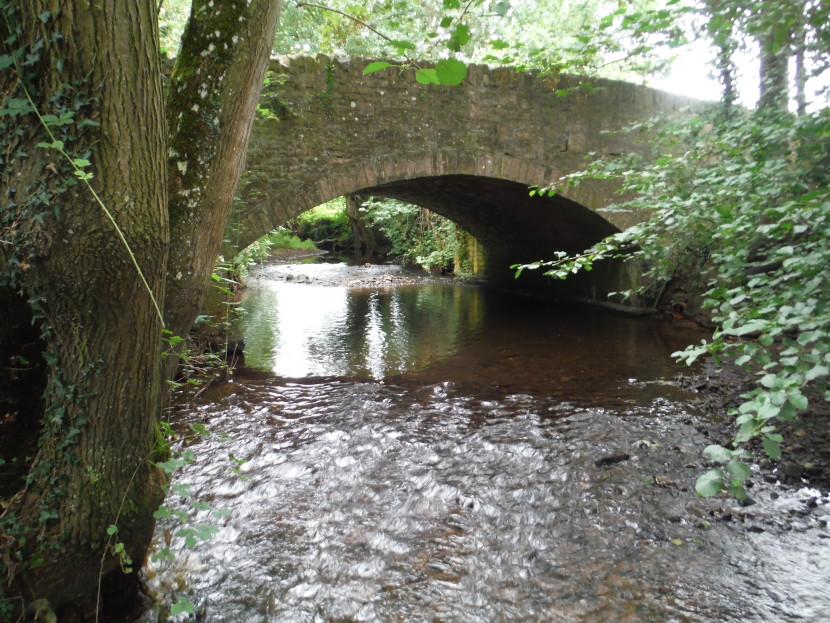 Our Wild Streams
Our Wild Streams Strange as this may sound, what sprung to mind was a story which my father used to tell us as kids. This was about something which had happened to him while taking a post-war PhD at Bristol. At that time, military service having intervened, a generation of mature students were back at college. Dad used to be the first to admit that he had enjoyed what used to be a called a “good war,” mostly spent training new pilots in what was then known as Rhodesia. In the immediate post-war years he had wangled himself back into the RAF Volunteer Reserve, which kept him flying at weekends and earned a little cash while he finished university. In this period they would have been flying Harvard and Chipmunk trainers and I think I can remember the helmet and oxygen mask hanging on the kitchen door of our Bristol apartment. I still have Dad’s log-book, which also shows 45 minutes on the new Gloster Meteor jet, which must have been exciting for him. The training school was based on Filton then and the family told me that on occasions Dad would cross the Severn and take an opportunity to make a low roll over his mother’s hill-top house in the Forest of Dean. She would come out and wave a scarf. Another bit of fun – actually a court martial offence, but everybody in the squadron did it at least once - was to fly under the spans of the old Severn railway bridge at Purton, the one which was eventually destroyed by fuel tankers which dragged their anchors in 1960. I can remember, as a teenager, pointing out to Dad that this kind of low level flying had not been entirely responsible behaviour. This was the best defence I could come up with at the time when he criticised me (no doubt deservedly) for riding motorcycles too fast.
My father’s old story which had just sprung to mind was as follows. In perfect flying conditions and with no pupil in the front seat he was coming in to land at Bristol’s Filton aerodrome. Everything seemed routine with the aircraft at the right attitude, engine throttled back, flaps adjusted down, no tendency to drift off-line or any other reason for worry. And then he glanced in his mirror and froze in horror. What he saw behind him were four huge whirling propellors bearing down rapidly and looking about to cut his light plane to pieces. It was the prototype of the Bristol Britannia, the world’s first turbo-prop air-liner, known as the “Whispering Giant,” then on flight trials at Filton, and now overhauling him rapidly on the same landing path.
“What did you do?” we asked Dad.
“Do? I got the hell out of there! I opened the throttle and bolted off sideways like a startled rabbit!”
Clearly the event had made a strong impression on him. It did strike me that somebody would have been seriously at fault in this case, either air traffic control, or the Britannia crew, or maybe my father. “Something must have gone frightfully wrong somewhere,” said Dad vaguely. I had more sense than to push the point and spoil a good story. But it struck me now that what had happened to that small trout was probably rather similar. There he was on station and perfectly happy in the run, he saw my fly as something edible coming down on the surface and rose to take it…but then suddenly became aware that Mr Big was coming up fast from behind. He did what any small fish would do, or indeed what Dad did, he got the hell out of the way!
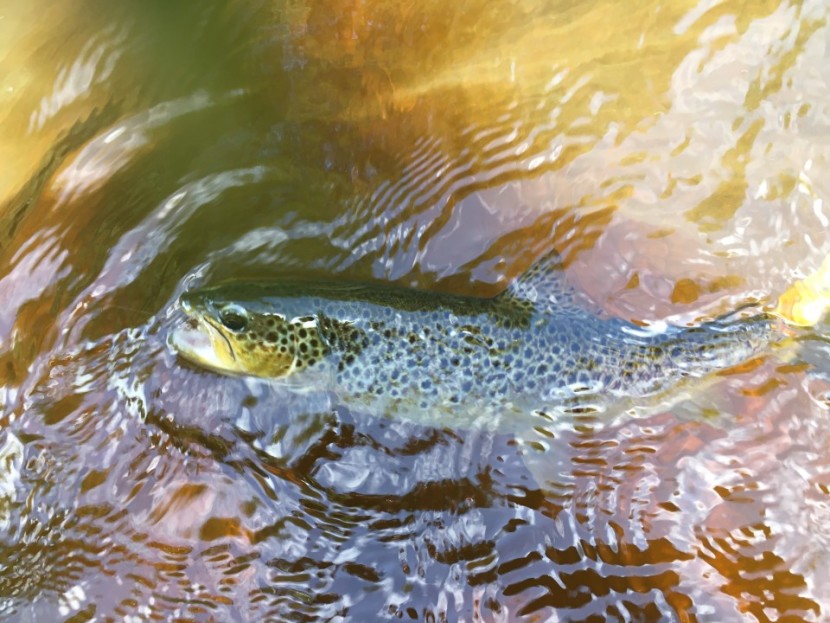 Cefnllysgwynne - PB from Churchdown
Cefnllysgwynne - PB from Churchdown 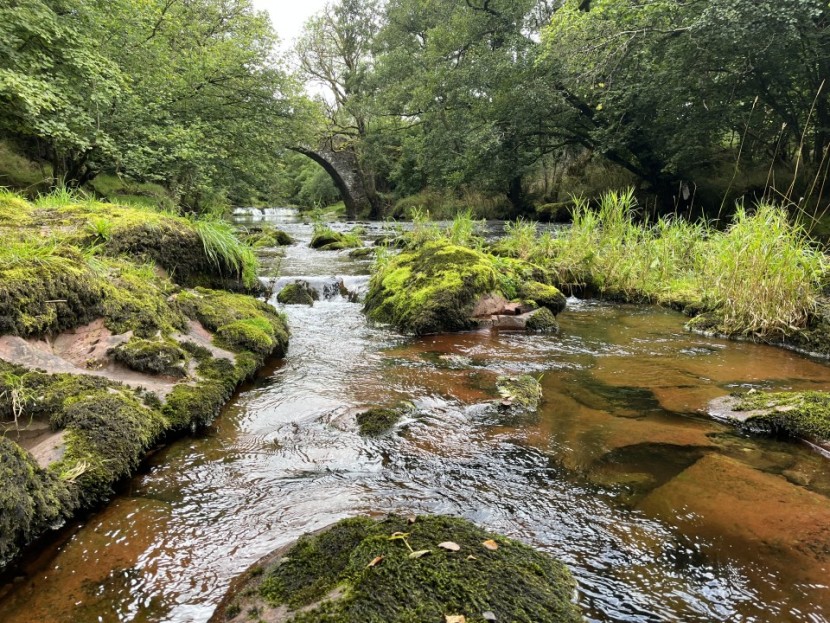 Pantyscallog - JB from Bristol
Pantyscallog - JB from Bristol 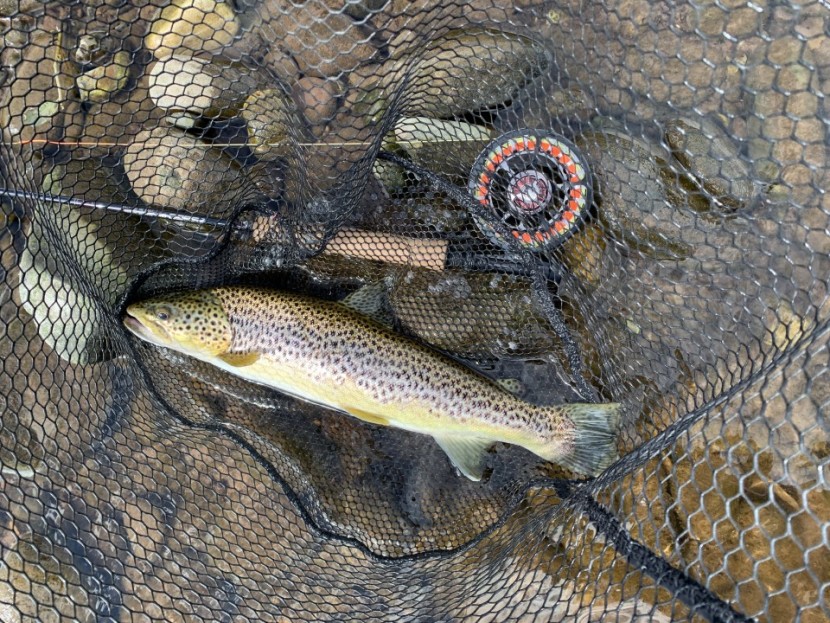 Greenbank trout - MR from Winchester
Greenbank trout - MR from Winchester Arguments about the predicament of the Welsh Wye continue to rumble around the hills and indeed through the whole United Kingdom. In a statement to the BBC, Welsh farmers via the NFU have now claimed they are not to blame for the damage to the river. Unfortunately, almost every other organisation including NRW is now convinced that they are to blame, even if some unpleasant sewage discharges have added to the problem. I do not wish to tar all farmers with the same brush; many have serious concerns about the riverine environment and some are even anglers, but it comes to something when the representative body seeks to deny a problem which is apparently obvious to everybody else. The BBC piece included what seemed to me the extraordinary information that 25% of the United Kingdom’s battery chicken production is now located within the Wye catchment. Much of this has been authorised within the last 5-10 years, a period almost exactly concurrent with the deterioration of the river and its wildlife. “Let’s have another scientific study to prove where phosphates and other so-called pollutants are coming from” cry the farmers, but wasting more time on yet another study is a delaying tactic which I hope will be universally opposed. I rather doubt that any battery chicken units will be closed given the financial investments involved, but any solution must involve trucking the slurry away to be spread on distant fields outside the catchment, distant fields which are known not to be overloaded with phosphates already. There will be a logistic cost to that so that the price of chicken meat and eggs will inevitably rise. Everybody likes chicken and we expect to have it cheap these days. I’m probably cooking a Thai chicken curry in my wok a couple of times a week – cooking and usually a beer to go with it is my way of relaxing - but I suppose we will have to accept some extra expense for the sake of our rivers.
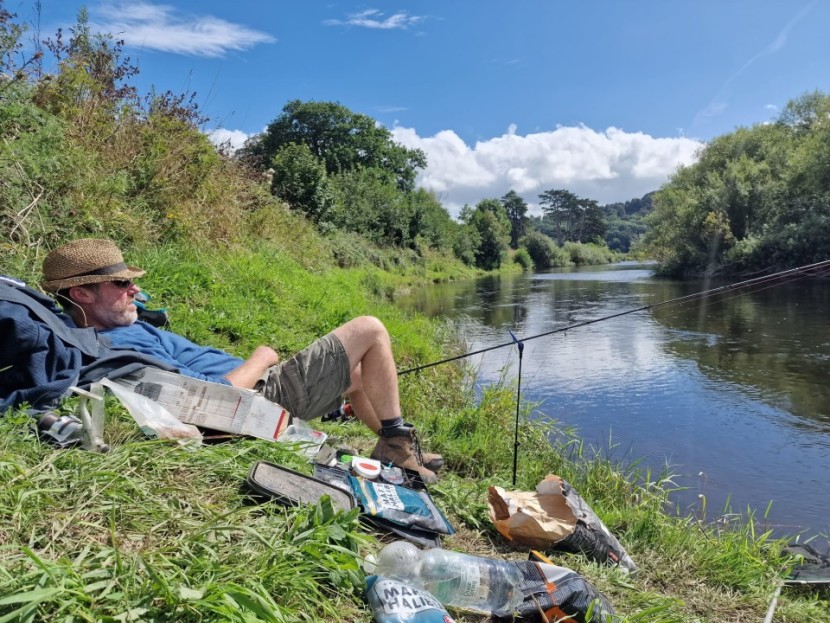 Whitney Court - TB from Normandy
Whitney Court - TB from Normandy 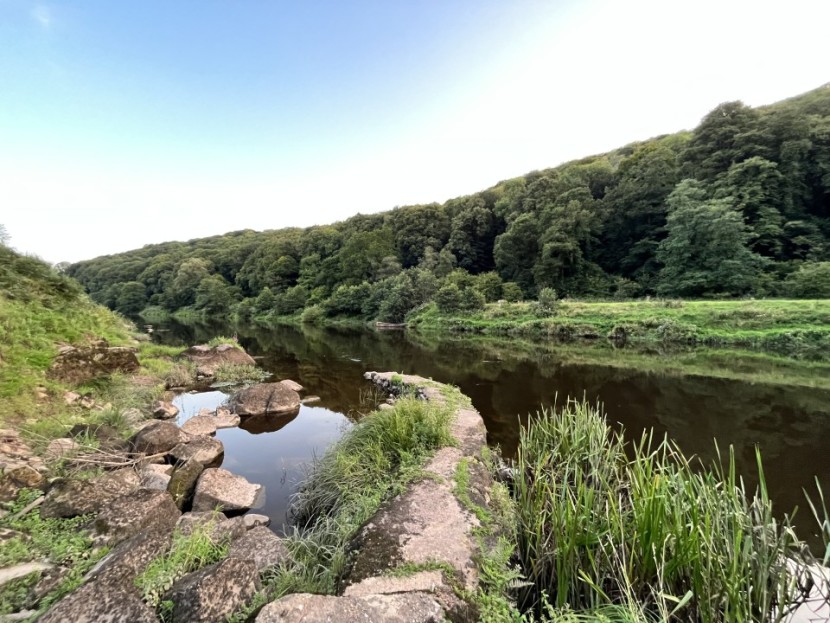 Upper Bigsweir - J from Rugby
Upper Bigsweir - J from Rugby Here’s a piece for petrol-heads and maybe those who care about the environment also. Is it possible to be both? Most of us who fish a good deal also drive a fair mileage simply in order to get to the rivers. There’s no getting round that fact and I have to admit that I still do more rural miles than most, and in a recent busy year I covered as many as 30,000 miles. There is no public transport alternative if I am to reach my various work places with a load of fishing kit. I care about the environment and I care to reduce my expenses, so at least I try to drive as economically as I can with light throttle openings and high gear selected when possible.
Now back in the day, or when I started driving at least, diesel engines existed for trucks and tractors, being considered far too noisy for powering motor cars. However, diesel fuel consumption per mile was always known to be more economic than that of petrol engines and over the years sound-deadening measures improved to hide that diesel rattle. Diesel exhaust emissions were said to be cleaner than those from petrol engines with their dangerous carbon monoxide. In time quite a few of us were thus persuaded to invest in diesel cars as the “greener” option. Then came a volte-face. The powers that be had a rethink about the exhaust emissions and their effect on human health and decided that in fact diesel engines were more dangerous than petrol engines which had now been cleaned up, first with lean-burn technology and then by adding catalyst exhaust systems. Back to petrol chaps!
Petrol engine technology itself had changed. Immediately post World War 2, the general availability of nothing more than low octane “pool petrol” meant that low compression ratios had to be used to prevent engine damage due to pre-ignition. My 1950 Norton motor cycle had a 6:1 compression ratio. After a few years lead was being added to petrol to improve its octane ratio so that, running on the 100 octane 5 star fuel of the day, 1960s high performance cars might have compression ratios as high as 10:1. That quickly ended when health problems caused by the lead were discovered, so we went over to lead free fuel of lower octane ratings. Older cars needed modifications such as different valve seats to cope with the lead-free fuel. But technology kept evolving and before long the micro-chip revolution meant that new cars had computers capable of detecting pre-ignition or “knocking” and automatically retarded the ignition to prevent it. The new engines had high compression ratios and comparatively high power outputs and could still deal with lead-free fuel of octane rating 95 and above.
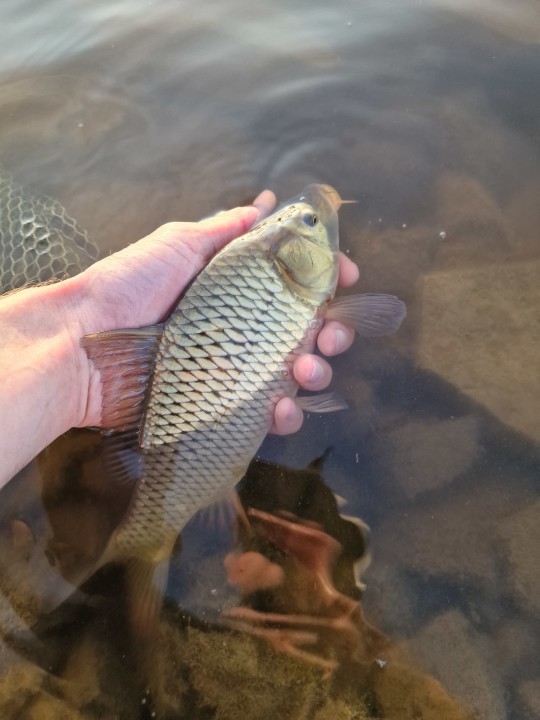 Pant y Llyn wild carp - T from Epsom
Pant y Llyn wild carp - T from Epsom A few years back, all our petrol stations were stocking the same lead-free petrol known by the defined EU standard as E5. This comprises a mixture of 95% fossil-derived petrol refined from oil and 5% plant-derived ethyl alcohol. Then some 2 years ago, a new lead-free fuel was introduced, defined as E10. This one, as you might guess, contains 10% ethyl alcohol. E5 has an octane rating of 97 or 99, while E10 has an octane rating of 95. Many petrol stations now stock E10 as the only petrol on offer. However, perhaps as some older and sports car engines are known to run badly on E10, some stations still offer E5 as a slightly more expensive “high performance” option. The choice exists at my own local station.
Now my wife and I are the proud owners of a fairly new and fuel efficient Japanese hatchback with a 13:1 compression ratio engine which, according to the owner’s handbook and the inside of the fuel filler flap, can run on either E5 or E10. When the new fuel came in, I took the government’s widely touted advice and switched to E10. And then watched as over a few weeks the cumulative fuel economy display gradually reduced from 72mpg to 68mpg. I didn’t think too much about it at the time as cold weather was coming on. I did give it some thought in the spring as the consumption figure failed to recover. I had a look at the small print in my car’s handbook which recommended that owners dissatisfied with their car’s cold weather starting, performance or economy should go back to using E5. Upon which I looked at HMG’s small print advice to motorists, which says roughly the same. I had no complaints about my car’s cold starting, but the performance did seem a little flat and the economy was definitely worse by about 6%. So I went back to filling the car with E5, which costs a little more per litre, but the zip in the performance was back. What’s more the cumulative fuel economy figure was creeping back again, even with faster cruising speeds. I worked out that the better fuel economy more than compensated for the slight additional cost of the E5 premium fuel.
So my question is, why would anybody want to buy E10 rather than E5 petrol for their car? What are we achieving? What advantage is there to anybody? Back to HMG’s online advice to motorists again. They admit that there might be an increase in fuel consumption of about 1.9% with E10 (although it is significantly more than that in my case) and that the cheaper cost of E10 does not make up for this. Or in other words that the average motorist will be out of pocket on E10. But, and here is the whole pivotal point of this piece, an extra 5% of the new E10 fuel is alcohol made from grown crops like maize or corn, rather than fossil fuel withdrawn from the ground and thus E10 is more beneficial to the planet. So despite the reduced performance of our cars and damage to our pockets, we should all be grateful. On reflection I am not sure I would have voted for that if expressed in those terms. Watch out for E15, which is apparently coming!
If we wanted to replace our little hatchback today, the same model would not be available. Instead the manufacturer offers a version with the same efficient petrol engine, but now only as a “mild hybrid.” This involves an additional and expensive lithium battery under the floor, which is charged up on the over run or during braking and contributes extra power during accelerating. I borrowed one of these from the dealer the other day while my earlier model was being serviced, and I didn’t like it. As a driver you always seemed to be braking or accelerating hard whether you wanted to or not; it didn’t seem possible to cruise in a high gear with a very light throttle opening as is usually best for economy. Previous drivers didn’t seem to have achieved a very good economy result; the cumulative fuel consumption figure on this one’s gauge was reading below 50 mpg. I asked the service receptionist if he had driven it and what he thought of it, and after checking left and right he told me quietly that he thought it was horrible.
In just a few years even this option will not be available; we will be obliged to buy fully electric cars. Some friends with deeper pockets than mine have already invested in them. They are invariably people who need to drive much less than I do. To be more accurate they seem to fall into two groups: those who don’t drive much and those who now admit to being very disappointed with what they have bought. After just a few years of use, I learn that the practical range of all-electric cars, particularly should you be unwise enough to use the heating or air conditioning as well as driving the thing, is often not much more than 100 miles. This might be improved by spending thousands more on a new battery pack. I couldn’t do my daily job with a 100 mile range and I would find life pretty problematic with a 200 mile range My little 70 mpg petrol hatchback has a range of 500 miles. I find it quite credible that after careful servicing in about 10 years’ time and were the industry encouraged to continue developing the petrol engine, I might be able to change it for a similar car capable of perhaps 80 mpg by then. What seems more likely (always assuming I am still around) is that I will be obliged to scrap my efficient little machine before time and change it for a newly manufactured and very expensive fully electric car using rare minerals in the battery. And the replacement will not meet my business motoring needs. Which of these two options will cause most damage to the environment and most inconvenience to me? The concerns about high price, the environmental cost of manufacturing new vehicles, limited range and lack of charging network are too well known to keep repeating here but, believe me, these days our rulers don’t care too much to be pandering to the tastes of voters who drive cars. This seems amazing, as for most of us the simple possession of a motor car has always represented freedom and potential for so many aspects of life. However, those “rulers”, or the policy-defining establishment if you prefer, tend to dwell in central London where ownership of a car is more of a hindrance than a necessity: “I only use it on the odd weekend and where to park it the rest of the time?” For the rest of us, particularly in rural and even suburban areas, cars are not an optional extra and there is little sign of public transport being improved to fill the need.
The motorists who should really be worried are those who live or drive in Wales. “No new roads” was the recent message from the neo-puritan policy-makers of Cardiff, presumably meaning once the EU funded Heads of the Valleys road dualling project is finally completed. Instead Wales is to have fewer cars, or at least no more cars than at present. The policy to change almost all urbanised areas of Wales to a blanket 20 mph speed limit is openly admitted to be aimed, not just at safety, but at encouraging people away from cars and onto bicycles. You can see the results already when you drive across the border; cars are crawling like beetles along empty suburban roads in second gear while the drivers wonder what on earth is being achieved either for road safety or the climate. If present policies continue, I have a strong feeling that Britain’s motorists are in for a bit of a shock. What comes next? Expansion of ULEZ tax collection schemes apparently. And then road charging by the mile? Addressing climate change is going to be a painful affair, whether or not the planned changes are going to work. If somebody can reassure me, I would love to hear from them.
Another bit of bad news received this last month might eventually affect anglers. Following the revelations about the attempt by Natwest and Coutts to de-bank Nigel Farage, we learn from the BASC that a large number of companies and organisations involved with sporting guns and their maintenance have recently had similar problems accessing banking services. The problems, now reported to the FCA, have affected gun-smiths, game shoots, sporting shooting grounds and high street shops. Apparently some banks today just don’t like fire arms, whether they are used for pest control, driven pheasants or just plain shooting at clay targets. And several of the shops so punished have been supplying fishing tackle as well as guns and ammunition – a very common combination. For some people making bank policy, or so it seems, these are all “blood sports” and those taking part are to be included on the growing list of “wrong thinkers” to be shunned and made to feel ashamed. As someone who devotes a lot of cartridges to merely trying to break clay plates, the assumptions involved here seem pretty annoying. The gap between the country and town view of sporting ethics and indeed the world generally seems to be growing ever wider.
Yevgeny Prigozhin, leader of the Wagner private military group and instigator in June of the attempted mutiny based on Rostov on Don, died in a plane crash north of Moscow on 23rd August. Somehow I didn’t think he would be around for very long. Vladimir Putin in a distinctly chilling eulogy commented that he: “…made mistakes in his life but achieved results.” Meanwhile the Ukrainian war grinds on, with only a few kilometres of land and some deserted, shelled villages having changed hands during the much advertised counter-offensive of 2023. Another winter is not far away, there is no military conclusion in sight, and I can see no serious diplomatic peace efforts on the horizon. Thinking back just 18 months to the beginning of this war and all the claims then made in the West for the disincentive effect of sanctions, maybe it is time to take stock? How much effect do the sanctions of Western nations on Russia seem to be having? Putin currently has an 80% approval rating we are told. And how well are we standing up to Russian sanctions on us, including high fuel and food costs?
A happier thought is that September comes now, a month which for me should provide the first of the real autumn surface fishing as flies start hatching again. Those little grey seasonal insects, the willow flies and the pale wateries, should be provoking spreading rings from sipping grayling. Size 16 or 18 Grayling Steel Blue or Grey Duster on a fine tippet should do the trick. Let’s be hopeful.
Oliver Burch
